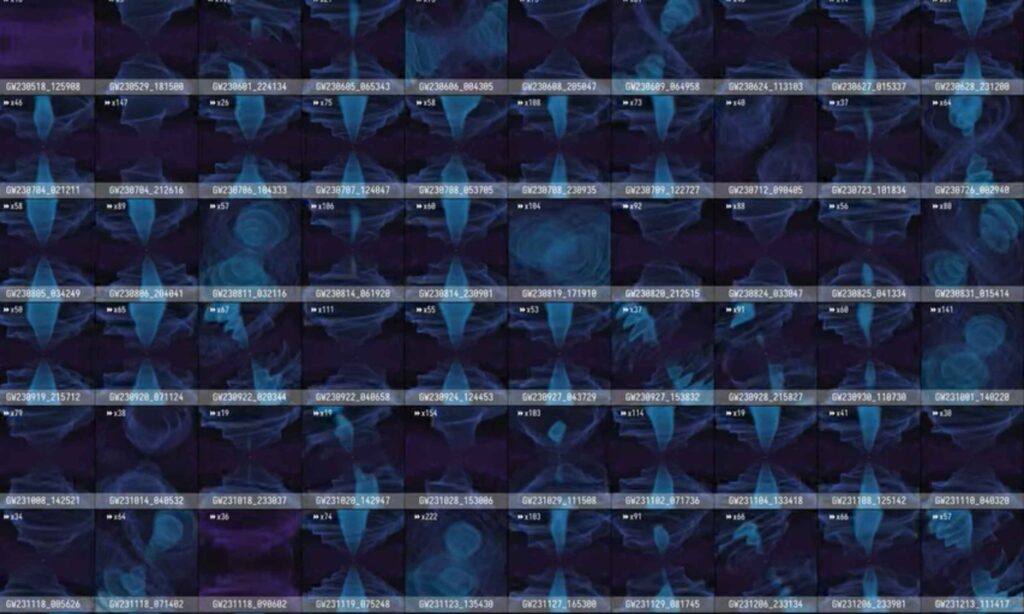
An international network of observatories has unveiled version 4.0 of its catalog, listing an impressive 128 new black hole merger candidates detected during the initial phase of the fourth observing run, O4a. This significant update enhances the list of black hole and neutron star collisions identified by detecting minute ripples in space and time, known as gravitational waves. This innovative gravity-based listening technique uncovers events that traditional telescopes often overlook.
The release of this catalog marks a pivotal moment in astrophysics, as it provides critical insights into the universe’s most enigmatic phenomena. With the ability to detect gravitational waves, scientists can now observe cosmic events that were previously invisible, offering a new perspective on the formation and evolution of massive celestial bodies.
Importance of Black Hole Mergers
One of the leading figures in this field is Dave Reitze of Caltech, who serves as the executive director of the Laser Interferometer Gravitational-Wave Observatory (LIGO). Reitze has dedicated years to advancing the sensitivity of detectors to capture fainter and faster signals. The increasing number of detected events allows for more rigorous testing of how nature constructs heavy objects. As the catalog expands, patterns in mass and spin begin to emerge, revealing the likely formation environments of these systems.
Some black hole systems originate in densely populated star clusters, while others form in isolated pairs. More precise measurements reduce uncertainties in theoretical models, transforming catalogs into valuable insights about stellar life cycles. This knowledge helps scientists understand where stars are born, how they evolve, and where they meet their end.
GWTC 4.0: A Comprehensive Catalog
The GWTC 4.0 catalog is not merely a compilation of names and numbers. It includes detailed properties for a broad set of confirmed detections and flags events requiring further scrutiny. An accompanying paper describes the open data set, featuring main recordings, instrument specifics, and data quality notes. It also provides a user-friendly tool for scientists to explore events and verify findings independently.
The catalog encompasses sources that merge into black holes of varying sizes and includes candidates involving a black hole and a neutron star, a dense stellar core. Each entry details the signal’s arrival time, strength, and the most probable masses and spins. Researchers utilize these data points in population studies to uncover broader trends.
Record-Breaking Detection
Among the numerous detections, a record-breaking event from November 23, 2023, stands out. This collision resulted in a black hole approximately 225 times more massive than the Sun, the largest confirmed through gravitational waves to date. The component masses fall within a range that challenges conventional models of single star collapse. The data suggest that at least one of the black holes may have grown from previous mergers.
“This observation once again demonstrates how gravitational waves are uniquely revealing the fundamental and exotic nature of black holes throughout the universe,” said Dave Reitze.
This perspective underscores the transformative impact a single extreme event can have on our understanding of massive black hole formation. This particular event will serve as a cornerstone for future studies on spin and environmental influences, providing theorists with a clear target for testing black hole growth models.
Detecting Black Hole Mergers
A binary black hole merger emits a distinct pattern in frequency and time, enabling scientists to determine the masses of the two objects and the resulting remnant. An interferometer, a device that splits laser light along two perpendicular arms and compares the timing as the beams return, is crucial in this detection process. Passing gravitational waves cause one arm to stretch slightly while squeezing the other, manifesting as a change in the interference pattern.
The measured quantity, known as strain, represents a fractional change in length. Detectors record this strain tens of thousands of times per second, with patterns in the strain corresponding to the system’s mass and spin. Enhanced calibration and reduced noise levels refine these inferences, leading to more accurate measurements.
What Comes Next
The fourth observing run is set to continue into 2025, with additional weeks of data awaiting analysis. The team will incorporate new results as they pass internal validation checks. The collaboration also issues public alerts for candidate events in real-time via NASA’s General Coordinates Network, assisting telescopes in searching the sky for any accompanying light or particle signals from rare sources.
New detections will continue to enrich our understanding of massive object formation and behavior. Each discovery adds detail about their size, motion, and interactions with their surroundings. These findings also enable scientists to verify whether the laws of gravity remain consistent under extreme conditions.
As researchers delve deeper into the signals, they will monitor for subtle effects that occur when light or waves pass near very heavy objects, which can bend and brighten what we observe from across the universe.
Explore the Data Yourself
The open data is accessible to anyone interested, with tutorials available from the community. Students, educators, and enthusiasts regularly develop tools to elucidate key concepts and processes. The interactive “Masses in the Stellar Graveyard” visualization plots black holes and neutron stars detected through gravitational waves alongside those found using light.
This comparison highlights the strengths of each discovery method, with gravitational waves excelling at identifying heavy, dark pairs that do not emit light. As the catalog expands, this visualization fills in new areas of parameter space, mapping how stars live, collide, and ultimately perish.
For more engaging articles, exclusive content, and the latest updates, subscribe to our newsletter. Explore the universe with EarthSnap, a free app brought to you by Eric Ralls and Earth.com.





